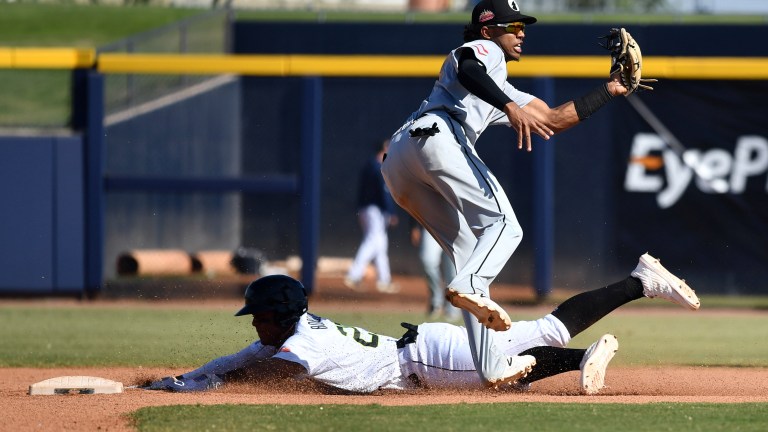Stolen Bases: MILB’s New Misleading Stat
Bases are being stolen at a historic pace in the minors leagues.

Major League Baseball loves to treat minor league players as guinea pigs for its new rules, and 2021 has been no different. The League has implemented new rules for base runners and pitchers in the lower levels of the minor leagues, which has caused a bit of a statistical ripple effect.
In an effort to bring more action into the game, MLB decided to test out some new rules in the minors from top to bottom. It seems as though the lower the level, the more drastic the rule experimentation is.
In Triple-A, they made the bases several inches larger. Double-A, they placed limitations on the shift, which has yielded little to no results so far. For High-A, pitchers must fully step off from the rubber before throwing to a base, and in Low-A, step-offs and pick-offs are limited.
It’s no surprise that the most dramatic change in stolen base numbers has been in the lower levels, as pitchers seemingly have no chance at keeping runners close. Stealing bases is an art that requires more than just speed, its about getting a good jump and going on the right pitches. Guys like Tim Anderson and Isiah Kiner-Falefa are currently in the top five in Major League Baseball for stolen bases, and while both are quick, they sit at about the 70th percentile in sprint speed.
Despite being “slower” than nearly 30% of the league, Kiner-Falefa and Anderson are matching some of the fastest players in baseball in SB, including Trea Turner and Fernando Tatis Jr.
It is becoming increasingly difficult to determine who is actually a genuinely good base stealer through the lower levels, because even I could steal some bases with the new rules. In 2019, High-A games averaged .79 stolen bases per game. So far in 2021, High-A games are averaging 1.3 SB/G.
Base runners are able to get bigger leads since right handed pitchers have to step backwards off of the rubber, rater than a quick pivot. Also, if a pitcher throws over to first a couple times, the runner can get a huge lead, knowing that the pitcher is restricted from throwing over again. Most importantly, left handed pitchers can’t leg lift and throw over to first. They must snap throw. I’d imagine Andy Pettitte is somewhere shaking his head.
Of course, stolen bases aren’t a determining factor for a player’s success, but it can definitely be a nice component when looking at how valuable and dynamic a prospect can be. For instance, Rockies top prospect Zac Veen is a fringe plus runner whose calling card is his incredible raw power.
This season, Veen already has 24 stolen bases in 44 games. While he hasn’t tapped into the power yet (1 HR in 44 G), you could look at his stat-line and say, “Wow, Veen could be a 30-30 guy.” The outrageous thing is, despite the fact that Veen has 24 times more stolen bases than home runs in his young career, I’d be shocked if Veen stole 30 bases in the big leagues before he hits 30 home runs.
Veen is just one example of many. In 2019, 22 players stole 30 or more bases between Low-A and High-A. So far this season, 12 minor leaguers have already swiped at least 20 bags, and roughly 60…SIXTY players are on a loose pace for 30 SB.
For catchers, caught stealing percentage has become pretty useless because half of the time they don’t even have a chance to gun down the runner. Fortunately, scouts and teams can look at arm strength and pop time when evaluating catchers. If your favorite catching prospect’s CS% has dropped, don’t be alarmed. After all, Low and High-A stolen base success rate is up nearly 10%.
At the end of the day, stolen bases will hardly ever make or break a prospect’s value, but the ability to get yourself into scoring position is a pretty nice bonus that will be much more difficult to detect. With Triple-A seeing reasonable improvements in stolen base numbers with the larger bases, changing the size of the bags could be a feasible solution to baseball’s desperate effort to, “bring action back to the game”.

